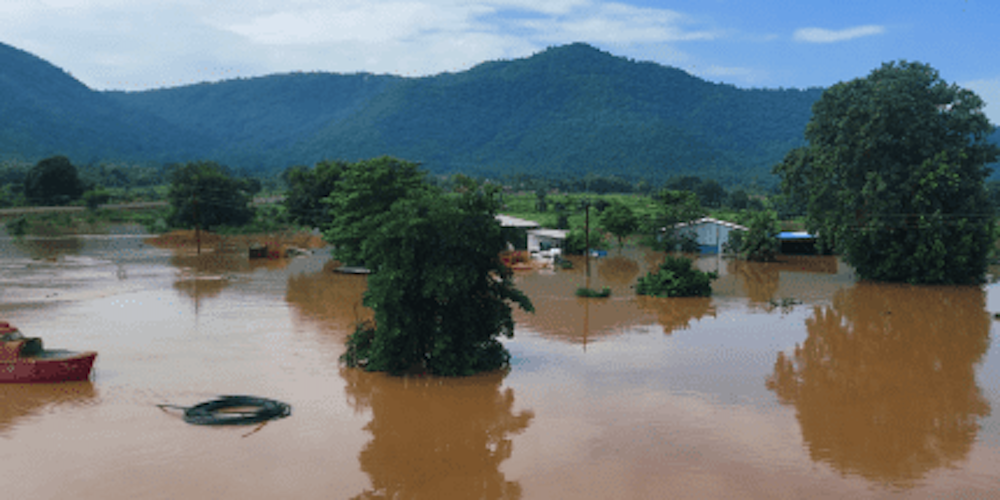SHALL WE STILL SAY – WAH IT IS RAINING ?

DATA OF RAIN
It is measurement and recording of the amount of precipitation, such as, rain or snow that falls in a specific area over a period of time. By having access to such data, one can understand patterns, trends and variations in precipitation.
TYPES OF RAIN
Usually these are four types : Convectional, Orographic, Cyclonic and Artificial. Last named is also known as Cloud Seeding. It is tried sometime over a limited area.
CATEGORIES
Intensity wise, there are five categories :
• Average Rain – When rain is below 2.5 m.m.,
• Light Rain – When it is 2.5 to 7.5 m.m.,a Day,
• Moderate Rain – In this situation, there is 7.5 to 36 m.m. of rain a Day,
• Rather Heavy Rain – Between 36 to 55 m.m. a Day, and
• Heavy Rain – rain is called so when ii is in the range of 65 to125 m.m. a Day.
LOW RAINFALL areas, on the other hand, are known so, as they receive 50 c.m.or less of rainfall.
Also it is important to know that DRIZZLE is not rain, rather, it is light rainfall falling in small drops over earth.
RAIN SITUATION : PAN INDIA
Coming to India as such, its a complete free fall situation this year, with fresh records being set and old ones being broken especially in North India, H.P., Punjab, Uttarakhand, NCR etc.
Top five rainiest states of the country are :
(1) MEGHALAYA : As the name itself will reflect, it abounds in rainfall.The state receives between 2000 and 4100 m.m. of annual rain. Mawsynram, located in East Garo Hills District (69 kms from Shillong), not only receives the highest rainfall in India (11,872 m.m. or 467.4 inches annually) but it is also wettest place on earth. In 1985 it created an all time record of 26,000 m.m. or 1000 inches of rainfall. Prior to it this coveted position was held by Cherrapunji.
Next in the category are Hilo in Hawaii and Londondessy in Northern Ireland.
Other areas receiving heavy rain in India are : Udupi, North And South Kannada, Hassan, Kodagu, Chikmaglur and Shimoga.
On the other hand, Jaisalmer, Bagalkot, Chitradurga and Koppal are among the places, receiving least rainfall.
(2) SIKKIM : Receives 3737 m.m.of annual rain. It rains almost ten months a year.
Among all six districts, Mangan should take a lead in this regard. Despite so much of rain, landslides during Monsoon and sinking zones, roads are in shape and better maintained vis a vis their counterparts in the NCR. Incidentally, even as on 2nd September, threat to N.H.10, the lifeline of Sikkim, continues. In October rain may subside but the threat from landslides may remain.
(3) KERALA : The green state having the distinction of welcoming South West Monsoon, receives 3000 m.m. of rain in an year. Many times Kochi and many other Districts have been flooded.
(4) ARUNACHAL PRADESH : The Eastern most state of the country getting first rays of Sun, receives over 2000 m.m. of annual rainfall.Though incidence of landslide & flood is on lower side as compared to Assam, Sikkim, J & K, Uttarakhand etc.
(5) WEST BENGAL : Also gets tremendous rainfall throughout the year but data in this regard is not readily available. Flood including flood water gushing, from Bangladesh is a perennial feature. It is a threat to the Border fence as well.
CHALLENGES FROM CURRENT SPELL OF RAINFALL
It is an excess rain situation in 2025 thus far, stretching right upto September 2. As per IMD’s recent forecast, free bounty from top is likely to spill over to mid September. For Delhi, it was almost fully wet July and the wettest August in 15 years with Yamuna flowing above danger mark of 205.33 metres from 27th to 29th August and from 31st August to 1st September. Total rainfall recorded in August has been 405.5 m.m.
GURUGRAM
In this millennium city, due to incessant rains since 31st August evening, a 8 kms long jam was caused on road to Delhi.Therefore, Work from Home has been ordered and schools also shut or partially closed.100 m.m. of rain in 3 to 4 hours has shaken the confidence of citizens. Knee deep water in many important localities and use of boat instead of automobiles is pointing at severe dangers ahead from health and sanitation points of view.
SITUATION OF DELHI
It is worsening day by day. Yamuna has crossed the danger mark of 205.33 mtrs for the third time since August 27. It was 204.02 mtrs in the evening of September 1. Fresh alerts have been issued and leftover people have been taken away from banks of the river. Release of 2,72,000 cuesecs and 4,29,000 cusecs of water from Hathinikund and Wazirabad barrages respectively, is going to add to the prevailing crisis. It is not only stagnation of water in many prime locations but accumulation of heaps of garbage that has emerged as a fresh and nauseating challenge both in Delhi and Gurugram.
With active Monsoon likely till 5th September, official closing date of Monsoon may, therefore, be also extended like extensions given in mystic and secret domain of Bureaucracy.

A HAYWIRE SITUATION
Current spell of rain may not be very drastic as compared to 2024 in terms of quantum but in regard to “shake and sound” and damage caused, it is uncontrollable so far. It is a haywire scenario in terms of visibility as well. Deluge of this kind caused in five of the eight Himalayan Union Territories and States, is catastrophic.
In a latest development, there has been inundation of large tracts of farmlands and villages in Punjab due to worst floods caused after 1988 by Sutlej, Beas, and Ravi rivers.
In the same way, flood waters and landslides have left a trail of death and devastation in Jammu & Kashmir. Jammu alone has recorded 380 m.m.of rainfall on 26th August, maximum since 1910. 45 pilgrims on the way to Vaishno Devi were killed by cloud burst leading to landslides.The C.M, J & K wondered as to why they were not warned in advance ? Officers on the spot had no answer.
There are similar reports of heart wrenching natural calamities in Doda, Reasi and Srinagar. While Tawi river has been a cause of deep concern for some time in the Jammu region, it is Jhelum river which is flowing close to danger mark in Srinagar.
Authorities do not want to take any risk in view of the 2014 flood in the capital city and surroundings. Not only National Highways are getting damaged owing to landslides in Punjab and J & K, breakdown of communication is not unusual due to damage to optical fibre cable lines.
ANA BRISTI vs ATI BRISTI
Shall we say, instead of “ana-bristi” situation, it seems to have become “ati-bristi” scenario ?Women inhabiting in Arid and dry belt areas may have certainly got a welcome temporary respite from fetching water, bare footed from sources located miles away from their dwelling units. But the woes of little school going children and senior citizens may have multiplied manifold. Similar may be the plight of petty businessmen and office goers, not having access to any mode of transport.
OVERALL EFFECT
Kharif, a few other crops, fruit and vegetable growers etc. may have gained or may be still gaining. But not the animals and birds. While animals donot take initiative in drenching themselves on their own, some birds, such as, Pigeons and Crows are often seen playing and enjoying pool of rain water, from our well positioned balcony. Rather, it becomes a relishing full body bath, they fervently look for. For such an experience or cleaning process, rich men ,women and pets have to cough up pretty big sum of money in beauty parlours/pet on move vans.
WELCOME RELIEF FROM NAUSEATING HEAT
On the positive side, urban dwellers welcome normal onset of rain situation as they sweat less upon getting relief from scorching and sweltering heat, have to drink less of water to quench their thirst and they are also supposed to save electricity when it drizzles, to get transformed into rain and finally it is downpour.
Thank You, God of Rain, Indra Bhagwan.
CONTINUING HAVOC IN 5 HIMALAYAN STATES
Officially 14 states are in strong and solid grip of rain, thunder and flood caused by Cloudburst in several places.
In many parts of Jammu & Kashmir (Ramban, Kishtwar, Kathua, Jammu ,Vaishno Devi etc),H.P.(Mandi, Chamoli, Manali, Kullu etc), Uttarakhand(Dharali, Rudraprayag, banks of Alaknanda, Bhagirathi), Rajasthan, M.P.,West Bengal (Kalimpong) and Sikkim(Gangtok & Pakyong Districts), rivers are back in spate killing at least, close to one thousand persons this year and injuring equal number of people.
In H.P. alone over 300 persons have died so far. 66 odd persons missing in Dharali devastation on 5th August are still untraceable. Painful game of death and devastation, it seems, is likely to continue at least till mid September. Although on 31st August the weather had cleared a bit but it rained heavily on 1st September. In view of latest IMD forecast, rain is likely to take place on a daily basis upto 4th or 5th September in Delhi, NCR and many parts of North India.
Chenab, Sutlej, Jhelum, Tawi, Rispana, Beas, Alaknanda, Bhagirathi, Ganga,Teesta etc are now creating havoc. Even the holy spot of Sangam in Prayagraj has been almost inundated. Earlier rain & slides were “gulping” roads, schools, temples, shops, vehicles, cattle etc, Gradually ferocious current in their water has begun weakening & sweeping bridges, entering hotels & resorts, damaging fields and lately begun entering dwelling houses and cattle sheds in a ferocious way. If reports are to be believed, due to rampant corruption, roads, hotels, resorts ,vacation spots etc have been permitted in hazardous zones and many of them are collapsing one by one.
LINE OF FINISH ?
A “line of finish” looks invisible, if not uncertain at the moment. Will it be a never ending flow ? When we prick our brain to find out the reasons for such a devastating situation, a popular myth that seems to become vocal is that these outbursts are as a result of our sins of the past or maybe, the immediate past. However, it may be just one side of the Spectrum.
IS GLOBAL WARMING ALL PERVADING ?
At a scientific level, change in ‘mood’ of mountains and glaciers and possible change in the course of rivers could be on account of Global Warming or GLOF or Climate Change.
Reasons for the breaking of IceBergs in Antarctica and other Arctic regions has already been ascertained. It is a strong case in point.
CONCLUSION
Not only 14 states of the country, unprecedented rain and release of excess water from India has swelled Sutlej, Ravi and Chenab rivers in Pakistan also. Flood water has entered Lahore after 40 years and severe flood has affected 1700 villages so far, including the Sikh shrine of Kartarpur.
C.M.,Punjab has demanded a huge sum of Rs 60,000 crores from Centre to tide over the flood crisis.
Has Nature Taken Over As Man Seems To be Moving On a Slow, If Not on a Failing Track ?
We may have to continue facing the onslaught if we don’t improve/mend our ways.Viable and workable long term steps shall have to be taken.There is no way out.
Finding a solution is urgently needed in the interest of humanity. GREED will have to go and the element of Need only should prevail.

(The author is former Chief Secretary, Sikkim)


